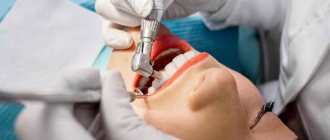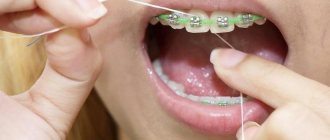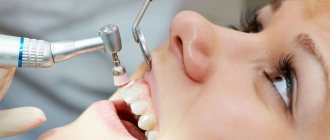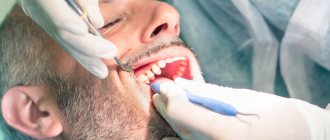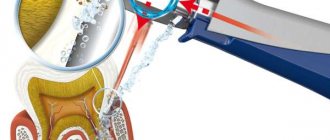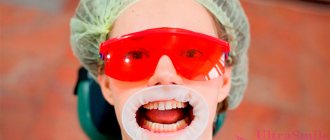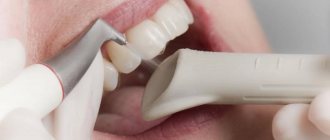Who is recommended for cleaning?
This procedure is recommended for any gum disease. It is usually prescribed when a patient is diagnosed with periodontal disease, periodontitis or gingivitis. Dental manipulation can also be performed if the following symptoms are present:
- Acute reaction to cold or hot.
- Bleeding gums.
- The appearance of “pockets” between the tooth and gum.
- Unpleasant odor from the mouth.
Indications
Cleaning periodontal pockets provides:
- complete removal of plaque and calculus from tooth enamel (including the surface of the crown in the subgingival part);
- protection against the appearance of cervical caries, carious lesions of the root part of the teeth;
- cessation of inflammatory processes that have already begun;
- slowing down the development of chronic periodontal diseases, prolonged relapse;
- elimination of foci of infection;
- strengthening of gum tissue, under favorable conditions - regeneration of bone tissue, strengthening of teeth.
Without regular professional hygiene, microorganisms accumulate on the surface of the enamel and on the subgingival part of the crown, forming plaque, which later turns into hard deposits (tartar). A layer of tartar separates the gum margin from the crown. The gum tissue is constantly injured, its nutrition is disrupted, and the ligaments supporting the tooth may gradually be destroyed, causing the teeth to become mobile and gradually loosen. The risk of such disorders is especially high for smokers, with poor oral hygiene, and with a predisposition to the occurrence of periodontal diseases. Professional hygiene with cleaning of periodontal pockets reduces it.
Execution algorithm
Before you begin cleaning, it is imperative to carry out some diagnostic procedures. Depending on the diagnosis and severity, different procedures may be required:
- Radiography.
- Sanitation of the oral cavity.
- Professional cleaning of units from stone and surface deposits.
The procedure is carried out in two stages, that is, the patient must visit the doctor twice. The algorithm for treating gums through cleaning is individual. Based on your cleaning goals, the steps may vary slightly.
- During the first session, hard formations located in the pockets between the gums and teeth are removed.
- Next, antiseptic treatment is carried out with special medications.
- The dentist applies a therapeutic bandage to the damaged areas of the gums.
- At the second visit, the dentist polishes the teeth and whitens the enamel several shades using an air-abrasive system.
- The final step is to apply fluoride varnish to the surface of the teeth.
After the procedure, a positive effect is observed. Using this procedure, it is possible to remove pathological bacteria, which are often the culprits in the development of oral diseases. After treatment, the likelihood of developing periodontal pathologies is significantly reduced, positive dynamics are clearly observed in existing diseases, and disturbing symptoms disappear.
Why is it worth supplementing professional hygiene with periodontal cleaning?
The condition of periodontal tissues affects the health of teeth. These tissues include the gums, periosteum, jaw bone, and supporting ligaments. The appearance of periodontal diseases is often provoked by insufficiently effective hygiene and associated inflammatory processes. Periodontal hygiene reduces the risk of developing periodontal diseases and stops them if they have already appeared.
Features of periodontal cleaning
Since with gingivitis, periodontal disease or periodontitis, the gums are hyperemic and painful, this manipulation can be performed with anesthesia. In this case, the patient will not experience pain or discomfort.
After cleaning, you must follow some rules to secure the result:
- From the moment the procedure is completed, you need to follow a dietary diet so as not to injure the gums and allow them to “heal” calmly. First of all, it is important to observe the temperature regime; food should be warm; cold and hot foods are prohibited during the week. You should also avoid salty, pickled, spicy, etc.
- The duration of the break between two sessions should not exceed seven days.
- Follow your doctor’s recommendations; depending on the diagnosis, the specialist may prescribe certain medications, rinsing the mouth with special solutions, etc.
- If necessary, a specialist may prescribe painkillers.
- Periodontal cleaning is not suitable for everyone; there is a list of contraindications. These include the period of bearing a child, breastfeeding, open foci of infection in the oral cavity.
Basics of periodontal teeth cleaning
Indications for periodontal teeth cleaning are various moderate and severe periodontal pathologies, such as periodontitis, periodontal disease, gingivitis, as well as structural features of the gingival and bone pockets of the patient’s oral cavity.
Before starting the hygienic procedure, an examination is carried out, a mandatory initial examination is carried out by drawing up a visual orthopantomogram and measuring the depth of the periodontal canals with special probes. In the process of periodontal teeth cleaning, sterile medical instruments, disposable masks, gloves, saliva ejectors and other personal devices are used, due to which the risk of infection of the patient during the procedure is completely eliminated. To eliminate pain, local injection anesthesia is used with modern drugs that provide reliable pain relief without any side effects.
Learn more about the benefits of teeth whitening and teeth cleaning
Indications and contraindications
Comprehensive professional oral hygiene is recommended to be carried out at least once every six months.
An unscheduled procedure is necessary in cases where the patient is undergoing various types of dental procedures:
- professional teeth whitening,
- treatment of caries and gum diseases,
- surgical intervention,
- implantation and prosthetics.
After professional cleaning, it is easier for the dentist to determine pathological processes in the dental system.
Oral hygiene is important during pregnancy. Against the background of hormonal changes, the viscosity of saliva increases, which contributes to the accelerated formation of dental plaque. The procedure is recommended to be carried out in adolescence and after a change in bite, since during these periods the degree of caries activity is the highest.
Contraindications depend on the complex of procedures. Thus, ultrasonic teeth cleaning is not carried out in childhood and adolescence, in the presence of milk teeth or recently erupted permanent teeth, due to the risk of injuring tooth enamel. In this case, dental plaque is removed using Air-flow.
Also, ultrasound is not used in the presence of arrhythmia, pacemakers, braces, or dental implants. Other contraindications are HIV, tuberculosis, diseases of the oral mucosa, bronchial asthma, hepatitis.
Comprehensive gum treatment in our Center
The procedure for curettage of periodontal pockets is part of the complex therapy of gum diseases. It is a basic technique - without cleaning the pockets it is impossible to achieve successful results, since it will not be possible to completely remove deep dental plaque using professional hygiene and rinsing the mouth with antiseptics. If the gum pockets are not cleaned out, the inflammatory process will progress, the periodontal tissues will be destroyed, and the teeth will gradually become loose and fall out.
But in advanced stages of the disease, curettage, as a separate procedure, also cannot always solve the problem. Therefore, an integrated approach is important for periodontitis, which includes the following measures:
- Professional hygiene Removal of dental plaque from the surface of teeth using ultrasound and Air-Flow sandblasting machine. Aimed at ensuring sterility of the oral cavity and preventing tissue infection during subsequent curettage.
- Splinting of teeth is mandatory for tooth mobility. In case of bone loss, teeth are held in place only by dental plaque. After cleaning, they remain without support and can fall out immediately during the procedure. To avoid this, thin fixing splints are placed on the inside of the teeth.
- Gum curettage Cleansing gum pockets from accumulated deposits. The technique is selected based on diagnostic results and depending on the stage of the disease.
- Surgical treatment: Gumplasty is performed in the presence of large periodontal pockets or, conversely, gum recession. In the first case, part of the mucosa is excised, and a new aesthetic contour is formed. In the second, the gum is grown by transplanting from the palate.
Additionally, anti-inflammatory and antibacterial drugs, periodontal dressings, and plasmolifting of the gums can be used.
We treat gums in a comprehensive manner! In our Center, only an integrated approach is used in the treatment of gum diseases. Relieving symptoms will not solve the problem. If the cause of inflammation is not identified and eliminated, over time the situation will only worsen, even to the point of tooth loss. Thanks to complex therapy, a combination of therapeutic, surgical and reconstructive techniques, it is possible not only to stop the pathological process, but also to restore up to 80% of destroyed periodontal tissue.
Differences between methods
| Closed curettage | Open curettage |
| Trauma is low | Traumaticity high |
| Depth of gum pockets up to 5 mm | Depth of gum pockets from 5 mm |
| Duration (in a segment of 6-7 teeth) 1-2 hours | Duration (in a segment of 6-7 teeth) 2-3 hours |
| Efficiency high, subject to correct diagnosis and experience of the doctor | Efficiency very high |
| Recovery 3-4 days | Recovery 2-3 weeks |
| Price low | Price high |
Note! Closed curettage is effective only for shallow gum pockets at the initial stage of periodontitis. For moderate and severe stage disease, only the open method is indicated! But in the absence of a periodontist surgeon in the clinic, even with deep pockets, they can offer a closed technique, which is performed by a dentist-therapist who does not have proper knowledge in the field of periodontology. The procedure may improve the condition for a short time, but the disease will progress in any case, since the infection is not completely eliminated. Subsequently, you will get an aggravation, suppuration from the gum pockets and accelerated resorption of bone tissue.
We recommend that you carefully choose a clinic and doctor. Only an experienced periodontist can assess how affected the tissue is, make a correct diagnosis and select an effective method.
Medvedeva Tatyana Alexandrovna
Dentist-periodontist, 6 years of experience
Specialist in the diagnosis and treatment of gum diseases. Conservative, surgical, regenerative treatment. Microsurgical operations without pain under sedation.
More about the doctor
Benefits of oral hygiene in Moscow
Dentistry Beskudnikovo is a modern multidisciplinary clinic. Provides a wide range of services to maintain healthy teeth and gums and treat dental diseases. The center is equipped with modern equipment for oral care. Specialists with significant experience select an effective set of hygiene procedures, taking into account the condition of the dental system and contraindications.
At Beskudnikovo Dentistry, professional oral hygiene is carried out at affordable prices. The cost depends on the complexity and stages of work, the presence of anesthesia. The initial consultation and development of a treatment plan is free.
Oral hygiene methods
At Beskudnikovo Dentistry, the procedure takes place in the following sequence:
- Examination of the oral cavity. Using a staple and an oral mirror, the doctor assesses the condition of the dental system and mucous membrane. If there are pathological changes, he plans treatment and sets a date for a second consultation. The patient is informed in advance about all stages, timing, and cost of the procedures. A preventive dental examination should be carried out once a year if there are no complaints.
- Air-flow teeth cleaning. Neutralizes soft dental deposits, in particular food dyes and smoker's plaque. Using a special powder with water under pressure, the chewing, lingual and palatal surfaces of the teeth, the interdental space are cleaned, and periodontal pockets, if any, are washed out. The procedure is absolutely painless and does not cause any harm to the enamel or gums.
- Ultrasonic teeth cleaning. Using an ultrasonic scaler, supragingival and subgingival tartar is removed from the surface of the teeth, in fissures, and interdental spaces. The doctors at Beskudnikovo Dentistry carefully break down all dental deposits, since the remaining stones injure the gums, pressure exposes the neck of the tooth, and increases tooth sensitivity.
- Polishing the surface of teeth and fillings. Special rubber heads, brushes, strips and abrasive pastes smooth out the enamel structure, remove chips, unevenness, cracks and roughness. Perfectly smooth enamel prevents the accumulation of food debris and plaque, which poses a great threat to periodontitis (inflammation of the tissue around the tip of the tooth root).
- Enamel coating with fluorine varnish. The final stage of oral hygiene. It is not carried out for all patients, but in cases of hypersensitivity of teeth, a tendency to caries, and also to increase the service life of fillings. Fluoridation is especially recommended for children after changing teeth, during periods of active growth and in the presence of braces.
The doctor must not only remove plaque, but also, if necessary, teach the patient the rules and methods of oral care and the correct technique for brushing teeth.
